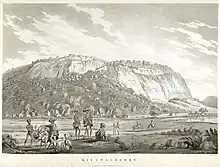Krishnagiri Fort, situated in the Krishnagiri district of Tamil Nadu, India, is a formidable historical stronghold that has witnessed the ebb and flow of various dynasties and colonial powers. This fortification, now preserved as a national monument under the auspices of the Archaeological Survey of India, holds a rich history dating back centuries.
History
The fort and its surroundings were commonly referred to as "Baramahal," a term that linguistically translates to "twelve forts." This nomenclature reflects the presence of twelve hilltop forts in the region, including Krishnagiri Fort. This majestic fort was built under the aegis of the Vijayanagara Empire.[1]
Vijaynagara chief Jagadevarayar-I migrated from Hyderabad to Penukonda. He showcased exceptional valor against the Bijapur army. His bravery earned recognition from Ranga Raya-II, a representative of the Vijayanagara Empire at Chandragiri, who granted him the Baramahal territory.[2] Here, he established Jagadevi as his capital, centered around the formidable Jagadevi Fort. This fortress stands among the three prominent forts in the region, alongside Krishnagiri, and Rayakottai Forts.
In the 1670s, the formidable Maratha leader Shivaji I captured the Krishnagiri Fort during his Deccan expedition.[3] Notably, the nearby MaharajaKadai Fort served as a trade post for the Marathas during this period.
During the 18th century, the fort faced yet another change in rulership when Hyder Ali, on the orders of Chikka Devaraja Wodeyar, the King of Mysore, captured the fort and the wider Baramahal region. Later, Hyder Ali retained control of these territories upon separating from the Mysorean monarchy and establishing his own capital in Srirangapatna. In 1768 AD, Krishnagiri Fort eventually surrendered to the British forces following a protracted blockade during the First Anglo-Mysore War. Subsequently, Hyder Ali reclaimed control of the fort, culminating in the Treaty of Madras.
In 1792 AD, following Tipu Sultan's defeat in the Third Anglo-Mysore War at the hands of the East India Company army and the subsequent signing of the Treaty of Srirangapatna, the East India Company assumed control of Krishnagiri Fort. Captain Alexander Reed was appointed as the first District Collector of the region under the Company's administration.[1]
The British strategically maintained Krishnagiri Fort as an arsenal, employing it as a pivotal defense structure to safeguard the region. However, following the events of the Sepoy Mutiny in 1857 AD and the subsequent transfer of control of India from the East India Company to the British Empire, the fort gradually lost its military significance. By 1900s, with the British rule firmly established in the region and no imminent threats, the fort fell into disuse. Finally, in the aftermath of India's independence in 1947 AD, Krishnagiri Fort came under the jurisdiction of the Indian government, marking the conclusion of its military role in the historical narrative.
Today, Krishnagiri Fort stands as a testament to its enduring historical significance and the myriad struggles for dominance that have shaped the course of its storied past.
| Krishnagiri Fort | |
|---|---|
| Part of History of Tamil Nadu | |
| Krishnagiri District | |
 Krishnagiri Fort in 1792 | |
 Krishnagiri Fort | |
| Coordinates | 12°32′21.64″N 78°12′44.33″E / 12.5393444°N 78.2123139°E |
| Type | Military Fort |
| Site information | |
| Owner | Government of India |
| Controlled by | Archaeological Survey of India |
| Open to the public | Yes |
| Condition | Ruins |
| Site history | |
| Built | 16th century |
| Built by | Vijayanagara Empire |
| In use | circa early 1800s |
| Materials | Granite |
| Garrison information | |
| Past commanders | Jagadevarayar, Shivaji I, Captain Alexander Reed |
| Occupants | Vijayanagar Empire, Maratha Empire, Mysore Kingdom, British Raj |
Gallery
 "Kistnagherry" fort painting by Sir Alexander allan
"Kistnagherry" fort painting by Sir Alexander allan "Kistnaghurry" fort painting by James Hunter
"Kistnaghurry" fort painting by James Hunter "East View Of Kistnaghurry" fort painting by James Hunter
"East View Of Kistnaghurry" fort painting by James Hunter Fort of Krishnaghirry
Fort of Krishnaghirry
References
- 1 2 "History | Krishnagiri District, Government of Tamil Nadu | India". Retrieved 1 November 2023.
- ↑ "Jagadevi Fort - Jagadevipalayam - Fort | Department Of Archaeology". www.tnarch.gov.in. Retrieved 30 November 2023.
- ↑ "The Campaign of the South". Chatrapati Shivaji Maharaj Memorial.